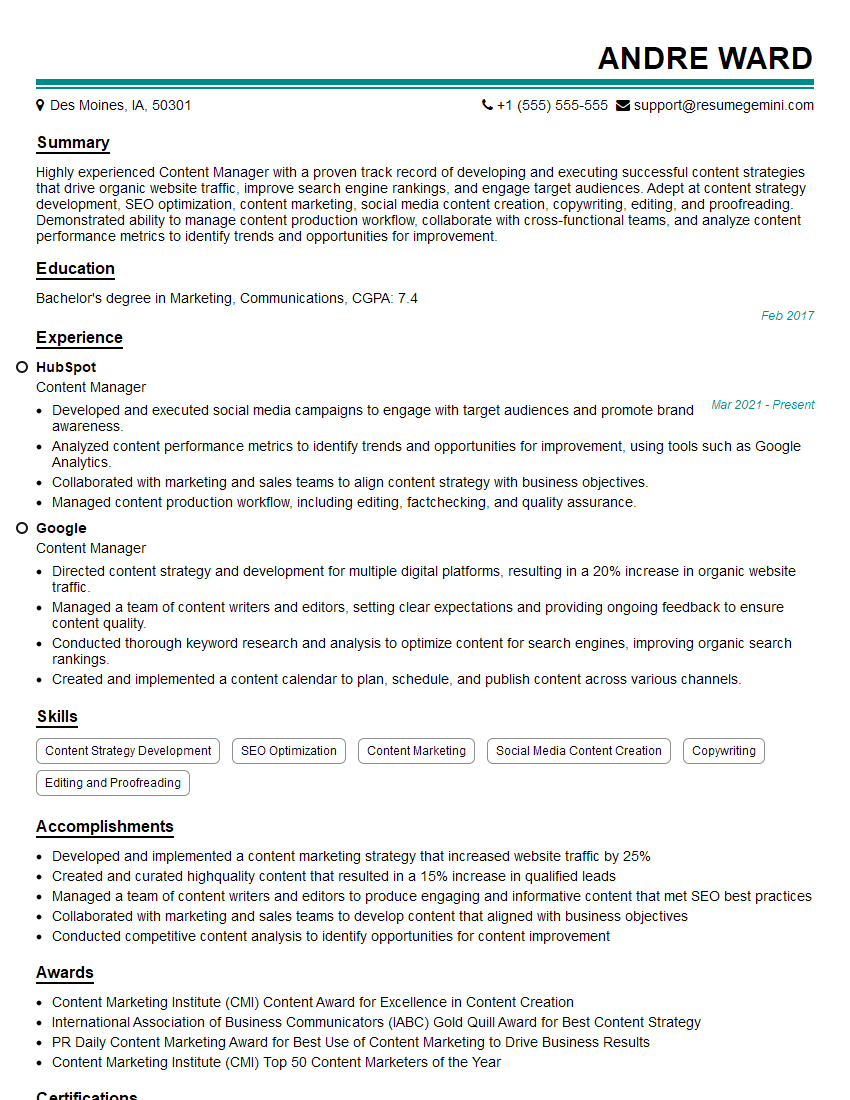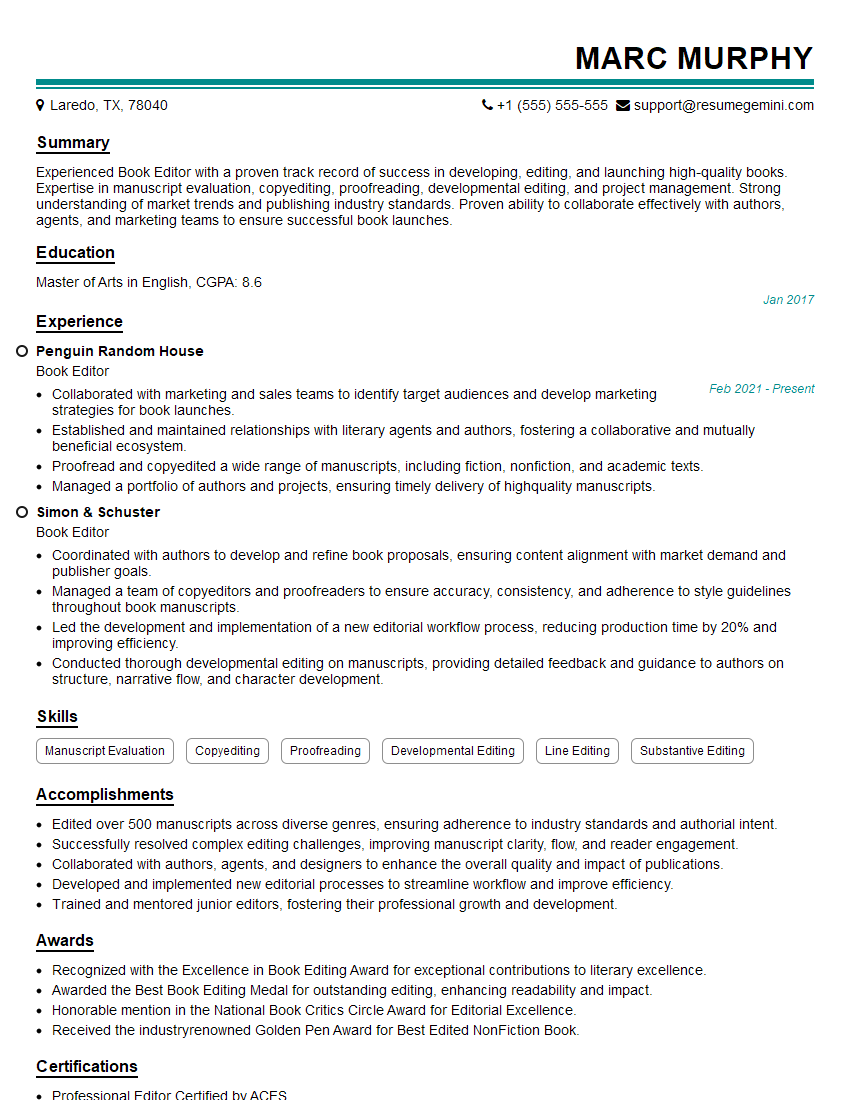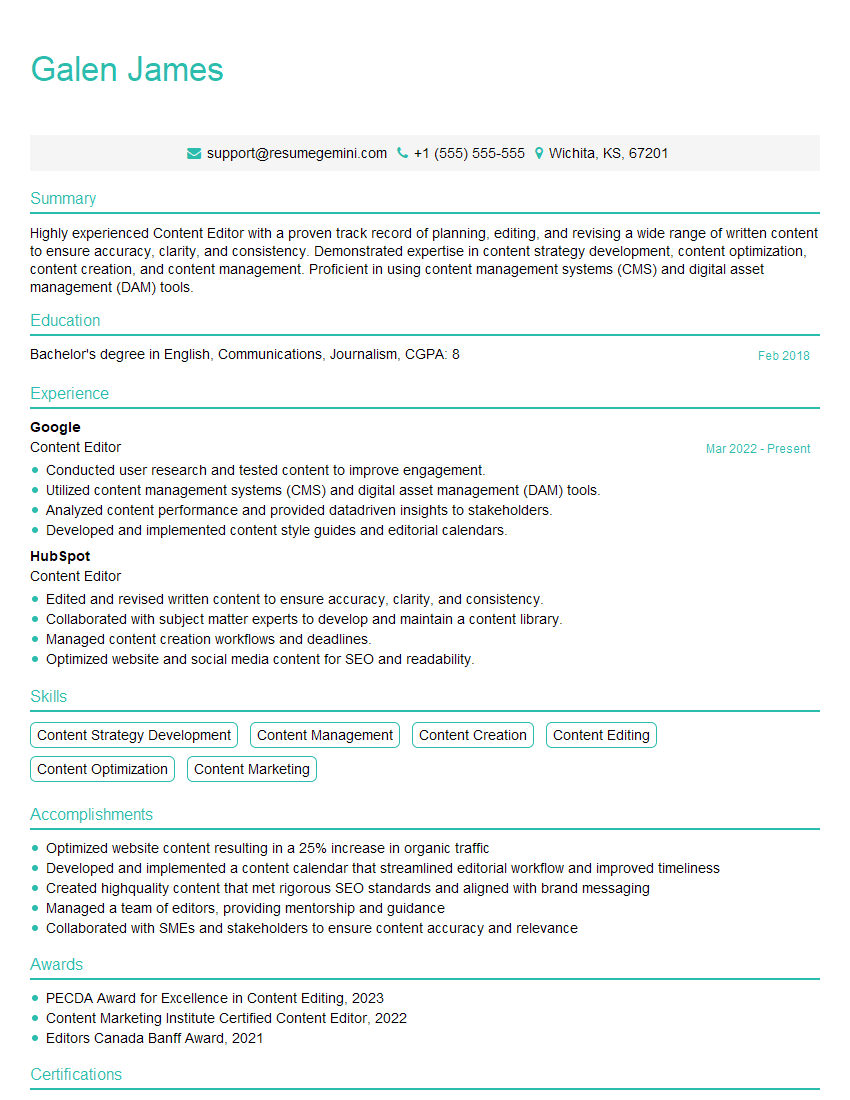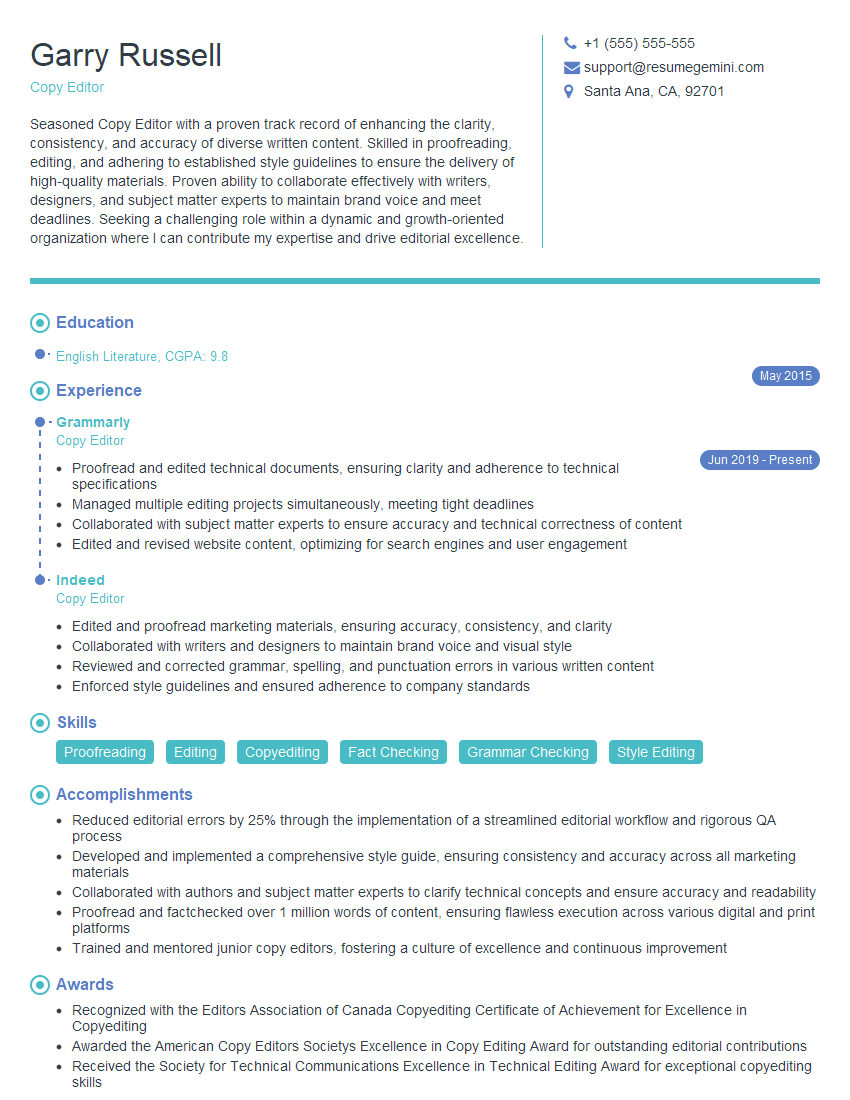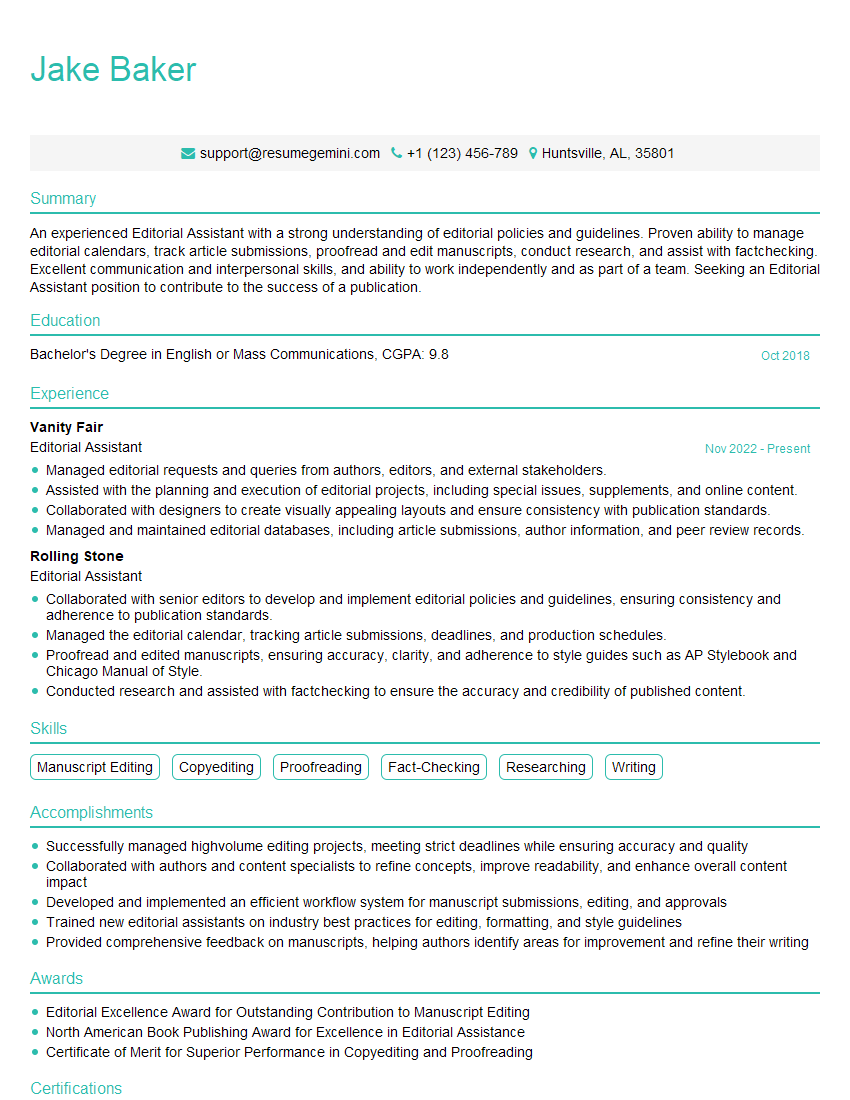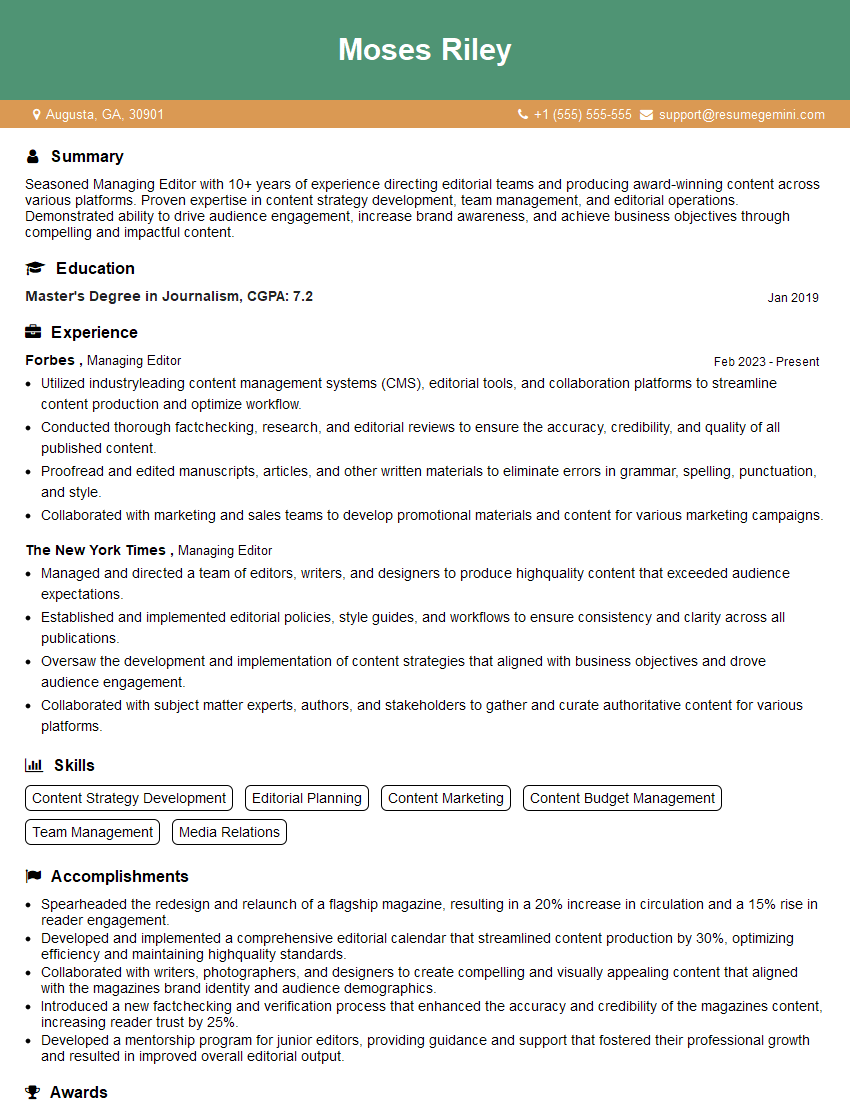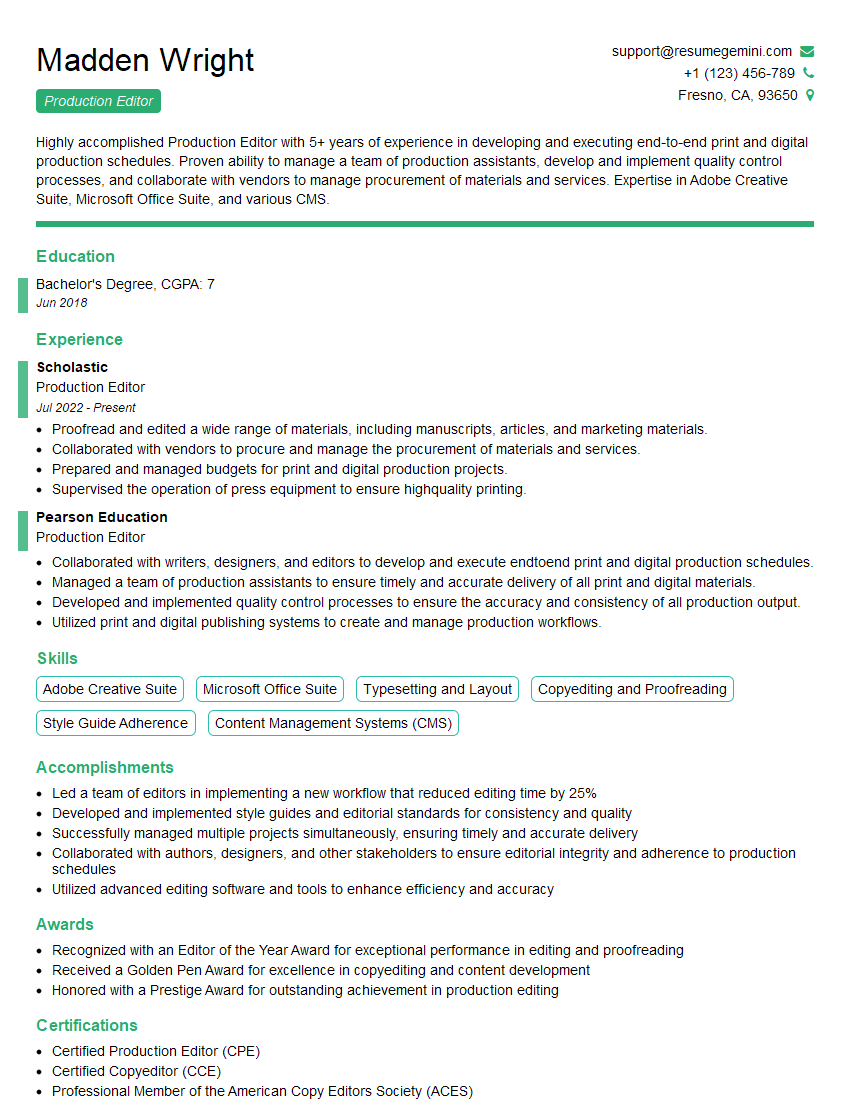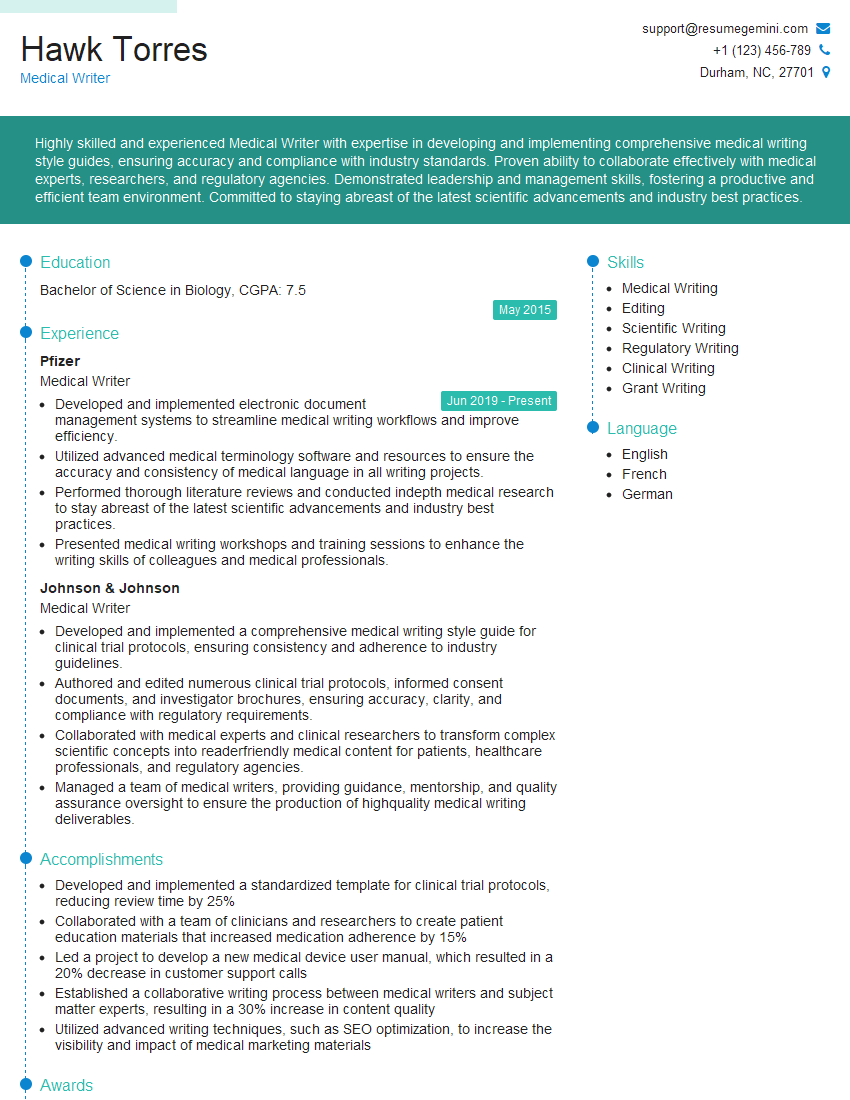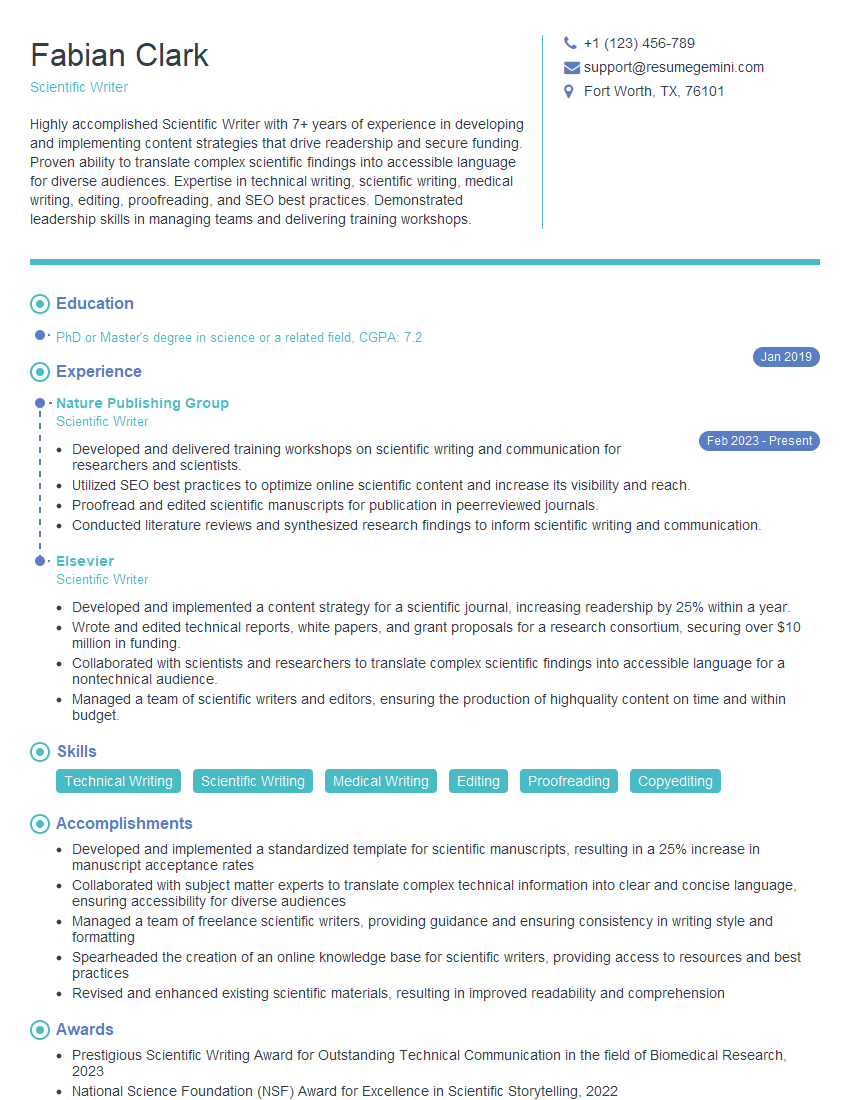Interviews are opportunities to demonstrate your expertise, and this guide is here to help you shine. Explore the essential Collaborate with Authors interview questions that employers frequently ask, paired with strategies for crafting responses that set you apart from the competition.
Questions Asked in Collaborate with Authors Interview
Q 1. Describe your experience working collaboratively with authors on complex projects.
Collaborating with authors on complex projects requires a multifaceted approach that blends strong communication, meticulous organization, and a deep understanding of the project’s goals. My experience involves working closely with authors from initial concept development through final manuscript preparation. This includes managing multiple revisions, coordinating with other team members (editors, designers, etc.), and ensuring that the final product aligns with both the author’s vision and the publisher’s standards. For instance, on a recent textbook project, I worked with a team of five authors, each responsible for a specific chapter. We used a shared online document system to track revisions and facilitate efficient communication. Regular check-in meetings ensured everyone stayed on track and addressed any roadblocks proactively.
- Project Planning: I start by clearly defining the scope of the project, outlining milestones and deadlines with authors, and establishing clear communication channels.
- Content Management: I utilize project management software to track progress, manage revisions, and maintain a central repository for all project materials.
- Conflict Resolution: Proactive communication minimizes potential conflicts. When they arise, I facilitate constructive dialogue to find mutually agreeable solutions.
Q 2. How do you handle conflicting viewpoints between an author and the editorial team?
Conflicting viewpoints between authors and the editorial team are inevitable in complex projects. My approach emphasizes open and respectful dialogue. I act as a mediator, ensuring all perspectives are heard and understood. I begin by clearly outlining the concerns of each party, identifying the root cause of the disagreement, and then collaboratively exploring solutions. The process involves finding common ground and reframing viewpoints to highlight shared objectives. For example, if an author insists on including a lengthy anecdote deemed irrelevant by the editorial team, I might suggest repositioning it as a supplementary online resource, maintaining the author’s contribution while addressing the editorial team’s concerns regarding length and focus.
- Active Listening: I prioritize understanding the rationale behind each viewpoint before suggesting alternatives.
- Compromise: I encourage mutual compromise to achieve a solution acceptable to all parties.
- Documentation: All agreements are documented to avoid future misunderstandings.
Q 3. Explain your process for providing constructive feedback to authors.
Providing constructive feedback to authors requires tact, empathy, and a clear focus on improving the manuscript’s quality. I always start by acknowledging the author’s strengths before addressing areas for improvement. I frame my feedback in a positive and supportive manner, focusing on specific suggestions rather than general criticism. For instance, instead of saying “This chapter is confusing,” I might suggest, “Consider restructuring this section by adding subheadings to improve clarity and flow.” I prefer to offer multiple suggestions, giving the author options rather than imposing a single solution. Constructive criticism requires balance – highlighting both positive aspects and areas for improvement. I usually provide feedback in stages, allowing authors to incorporate changes before providing further review.
- Specificity: Feedback focuses on concrete details with specific examples.
- Clarity: Suggestions are clear, concise, and easy for the author to understand and implement.
- Balance: Both positive and constructive comments are included to maintain author morale and motivation.
Q 4. How do you manage deadlines and expectations when collaborating with multiple authors?
Managing deadlines and expectations with multiple authors necessitates proactive planning and consistent communication. I begin by establishing a clear project timeline with well-defined milestones for each author and team member. Regular check-in meetings (virtual or in-person) are crucial to track progress, address challenges, and ensure everyone remains on schedule. I utilize project management tools to visualize timelines and track tasks efficiently. If an author experiences unforeseen delays, I work collaboratively to adjust the schedule, finding solutions while minimizing the impact on the overall project. Open and honest communication is key to preventing conflicts and ensuring everyone feels supported and informed.
- Project Planning Tools: Employing tools like Gantt charts or project management software is essential for effective timeline visualization.
- Regular Check-ins: Consistent communication ensures everyone understands expectations and can report on progress.
- Flexibility: Unexpected issues are inevitable. Flexibility and proactive problem-solving are key to managing setbacks.
Q 5. What strategies do you employ to foster a positive and productive working relationship with authors?
Fostering a positive and productive working relationship with authors rests on building trust and mutual respect. I prioritize clear and consistent communication, ensuring that authors always feel heard and valued. I proactively seek their input and actively listen to their concerns. Recognizing their expertise and acknowledging their contributions throughout the process is essential for maintaining a collaborative atmosphere. Establishing clear expectations from the beginning and offering regular feedback contributes significantly to a positive working environment. A simple “thank you” for their hard work can go a long way in building rapport.
- Open Communication: Encourage regular dialogue and feedback exchange.
- Respectful Collaboration: Value the author’s expertise and treat them as a partner in the process.
- Appreciation: Acknowledge and appreciate the author’s hard work and contributions.
Q 6. How do you handle author revisions and ensure the final product meets editorial standards?
Handling author revisions and ensuring the final product meets editorial standards is a crucial step in the publication process. I provide authors with detailed feedback on their revisions, clearly indicating areas that require further work or adjustments. I use a version-control system (such as track changes in Microsoft Word) to track all revisions efficiently. I collaborate with the author to ensure that all changes align with both the editorial guidelines and the overall project’s goals. Before final acceptance, the manuscript undergoes a thorough final review to ensure consistency and adherence to quality standards. If any significant deviations occur, I engage with the author in further discussion to find solutions. This meticulous approach guarantees a polished and error-free final product that meets both the author’s vision and the editorial standards.
- Version Control: Use of version control software is crucial for tracking changes and ensuring efficient collaboration.
- Clear Communication: Feedback is detailed and specific to guide the author through necessary revisions.
- Quality Control: A thorough final review ensures the manuscript adheres to editorial standards.
Q 7. Describe a situation where you had to negotiate with an author regarding content changes.
In one instance, an author insisted on including a controversial statistic in their manuscript, despite evidence suggesting its inaccuracy and potential to misinform readers. The editorial team felt it was crucial to either remove the statistic or include a strong caveat addressing its questionable reliability. My approach involved a calm and respectful discussion with the author, presenting the editorial team’s concerns and the potential negative consequences of including the statistic without proper qualification. We collaboratively explored alternative solutions, ultimately deciding to include the statistic with a substantial caveat acknowledging its disputed nature and offering a more reliable alternative. This compromise satisfied both the author’s desire to include the information and the editorial team’s concern for accuracy and reader understanding. The key was respectful communication, a willingness to compromise, and a shared goal of producing a high-quality and accurate publication.
Q 8. How do you effectively communicate with authors, especially during challenging situations?
Effective communication with authors, especially during challenging situations, hinges on empathy, clear and respectful dialogue, and a collaborative problem-solving approach. It’s not just about conveying information; it’s about building a trusting relationship.
When facing disagreements, I begin by actively listening to the author’s perspective, acknowledging their feelings, and validating their concerns. I avoid being defensive and focus on finding common ground. I might say something like, “I understand your frustration about the suggested changes to Chapter 3. Let’s discuss your vision for that section, and then we can explore ways to incorporate your ideas while ensuring consistency with the overall manuscript.” I then clearly explain the editorial rationale behind the suggestions, providing concrete examples and supporting evidence.
I utilize a structured approach to feedback, providing specific and constructive criticism, avoiding vague or judgmental comments. For example, instead of saying “This chapter is boring,” I might say, “This chapter could benefit from stronger character development in the initial scenes to create more engagement for the reader.” Finally, I always reiterate my commitment to the author’s success and emphasize that we are working together towards the common goal of producing the best possible book.
Q 9. What tools or software do you use to facilitate collaboration with authors?
Facilitating collaboration with authors requires leveraging various tools that streamline communication and project management. I primarily use a combination of software for different purposes.
- Project Management Software: Tools like Asana or Trello help track deadlines, assign tasks (like revisions or fact-checking), and maintain a clear overview of the project’s progress. I use them to create shared project boards where authors can see assigned tasks and their status.
- Version Control Systems: Google Docs or similar collaborative writing platforms allow authors and editors to work simultaneously on the manuscript, track changes, and leave comments directly in the text. This allows for real-time feedback and collaboration.
- Communication Platforms: Email is essential for formal communication, but for quick updates and discussions, platforms like Slack or Microsoft Teams enable efficient and organized communication.
- File Sharing Services: Secure cloud storage (like Dropbox or Google Drive) facilitates easy file sharing, especially for large files like images or supplementary materials.
Choosing the right combination of tools depends on the project’s size and complexity, as well as the author’s comfort level with technology. I always ensure the chosen tools are user-friendly and accessible to the author.
Q 10. How do you balance an author’s creative vision with editorial requirements?
Balancing an author’s creative vision with editorial requirements demands a delicate and nuanced approach, requiring skillful negotiation and compromise. The key is to recognize that both aspects are crucial for a successful publication. The author brings the story, and the editor ensures clarity, consistency, and marketability.
I start by thoroughly understanding the author’s artistic intent, asking questions to clarify their motivations and goals for the work. Then, I gently introduce editorial considerations, framing them not as restrictions but as opportunities to enhance the overall impact and reach of the work. For instance, while preserving the author’s voice, we might discuss improvements to pacing, character development, or plot consistency that could enhance the reader’s experience.
I often use analogies to explain editorial suggestions. For example, if the author is resistant to cutting a lengthy description, I might explain that it’s like editing a photograph – sometimes, removing elements enhances the overall focus and impact. Ultimately, the goal is to collaboratively refine the manuscript, making it the best possible version while retaining the author’s unique creative voice.
Q 11. How do you address concerns raised by authors about editorial decisions?
Addressing an author’s concerns about editorial decisions requires sensitivity, patience, and clear communication. I always approach such discussions with empathy and a willingness to listen.
First, I acknowledge the author’s perspective and validate their feelings. I might say, “I understand your concerns about removing that paragraph; it was clearly important to you.” Then, I clearly and respectfully explain the rationale behind the decision, offering specific examples and demonstrating how the change improves clarity, consistency, or narrative flow. I always present multiple options, if possible, allowing the author to feel a sense of agency in the final decision.
It’s vital to avoid defensiveness; I frame my explanations as suggestions for improvement rather than criticisms. If the author remains unconvinced, I’m open to further discussion and compromise, potentially finding alternative solutions that address both the author’s concerns and editorial needs. Ultimately, the goal is to reach a mutually agreeable solution that preserves the integrity of the work while enhancing its overall quality.
Q 12. Describe your experience with different author personalities and how you adapt your approach.
My experience working with diverse author personalities has taught me the importance of adaptability and tailoring my communication style to each individual. Some authors are highly communicative and collaborative, while others prefer a more independent approach. Some are detail-oriented, others focus on the big picture.
For highly communicative authors, I maintain frequent contact, providing regular updates and encouraging open dialogue. For more independent authors, I prioritize clear instructions and provide sufficient time for revisions. For detail-oriented authors, I ensure meticulous feedback that addresses every aspect of their work. For those with a broader focus, I offer high-level guidance and trust their judgment on specifics.
Regardless of personality, I always strive to build a strong rapport based on mutual respect and trust. I regularly check in, demonstrating my commitment to their project and creating a safe and supportive environment for collaboration. This personalized approach fosters a positive and productive working relationship, leading to successful publication.
Q 13. How do you maintain confidentiality and respect intellectual property rights when working with authors?
Maintaining confidentiality and respecting intellectual property rights is paramount. I adhere to strict ethical guidelines and contractual agreements throughout the collaboration process. All materials shared during the editing process are handled with utmost discretion.
I never share manuscripts or author information with unauthorized individuals. I use secure file-sharing platforms with appropriate access controls. I also ensure that all contracts clearly outline the ownership of intellectual property, ensuring the author retains their rights while allowing for the necessary permissions for publication and distribution. I always inform the author of any potential conflicts of interest, ensuring complete transparency. My commitment to confidentiality extends beyond the project completion, and I strictly adhere to data protection regulations.
Q 14. How do you ensure clarity and consistency in communication with authors throughout the project lifecycle?
Ensuring clarity and consistency in communication is crucial throughout the project lifecycle. I use a structured approach to ensure information is delivered efficiently and effectively.
- Project Timeline: Establishing a clear project timeline with defined milestones and deadlines from initial manuscript review to final publication helps maintain focus and manage expectations.
- Regular Check-ins: Consistent communication via scheduled calls or emails keeps the author updated on progress and allows for timely addressal of any concerns.
- Detailed Feedback: Providing specific, constructive feedback with clear explanations and examples promotes understanding and avoids ambiguity.
- Formal Documentation: Maintaining written records of all communication, including emails, meeting notes, and feedback, creates a transparent and traceable workflow.
- Consistent Style Guide: Utilizing a consistent style guide, shared with the author, ensures consistent terminology and formatting throughout the manuscript.
By employing these strategies, I guarantee seamless communication, fostering a collaborative and productive relationship with the author and culminating in a high-quality publication.
Q 15. What is your process for managing author expectations regarding timelines and deliverables?
Managing author expectations around timelines and deliverables is crucial for a successful project. My process begins with a clear and detailed project proposal outlining key milestones, deadlines, and responsibilities for both myself and the author. This proposal isn’t a one-time document; it’s a living document that we revisit and adjust as needed throughout the process.
I use project management tools to track progress, ensuring transparency. This could be a simple shared spreadsheet or a more sophisticated platform like Asana or Trello. Regular check-ins – weekly or bi-weekly depending on project complexity – are vital for open communication. During these check-ins, we review progress against the milestones, discuss any roadblocks, and proactively address potential delays. If delays are unavoidable, I work closely with the author to adjust the timeline collaboratively, ensuring they understand the reasoning and implications.
For example, if an author is struggling to meet a deadline due to unforeseen circumstances, I might suggest breaking down the task into smaller, more manageable chunks or offer alternative solutions like extending the deadline with a revised project plan. The key is proactive communication and mutual understanding to prevent misunderstandings and maintain a positive working relationship.
Career Expert Tips:
- Ace those interviews! Prepare effectively by reviewing the Top 50 Most Common Interview Questions on ResumeGemini.
- Navigate your job search with confidence! Explore a wide range of Career Tips on ResumeGemini. Learn about common challenges and recommendations to overcome them.
- Craft the perfect resume! Master the Art of Resume Writing with ResumeGemini’s guide. Showcase your unique qualifications and achievements effectively.
- Don’t miss out on holiday savings! Build your dream resume with ResumeGemini’s ATS optimized templates.
Q 16. How do you handle author requests that fall outside the scope of the project?
Handling author requests outside the project scope requires careful diplomacy and clear communication. The first step is to acknowledge and validate the author’s request. It’s important to understand the author’s motivation behind the request – is it a crucial element for their vision, or a minor addition?
Next, I assess the feasibility and impact of incorporating the request. This includes evaluating the additional time, resources, and budget it might require. If it’s a minor adjustment that doesn’t significantly affect the project’s overall direction, I may accommodate it, perhaps by adjusting other aspects of the project to compensate for the added work. If it’s a significant change, I clearly explain the implications, including potential cost overruns or deadline adjustments. I present alternative solutions that align with the original project scope, perhaps suggesting it for a future project or offering a different approach to achieve a similar outcome.
For instance, if an author requests a substantial addition of new research that was not initially planned, I might explain that it’s outside the agreed-upon scope and requires a separate contract. Alternatively, I might discuss how we could streamline the original scope to accommodate the new research, possibly with a revised budget and timeline.
Q 17. Describe a time you had to resolve a conflict between an author’s vision and the target audience’s needs.
In one project, the author envisioned a highly technical and detailed explanation of a complex scientific process, while the target audience—lay readers with limited scientific background—needed a simplified and engaging narrative. This presented a significant challenge.
My approach involved a collaborative process of finding common ground. I presented data demonstrating the target audience’s reading level and preferences. We then worked together to identify key concepts that needed to be conveyed accurately and engaged in brainstorming sessions to explore different ways to present this information accessibly. This included using analogies, simpler language, and visual aids to clarify complex ideas without compromising scientific accuracy. The author, initially hesitant, eventually recognized the value of reaching a broader audience, and the result was a book that resonated strongly with both the author and the target audience.
Q 18. What strategies do you use to improve communication and collaboration during the editing process?
Effective communication and collaboration are fundamental to successful author-editor relationships. I leverage several strategies to foster a positive and productive environment.
- Regular Communication Channels: I establish clear communication channels from the outset – email, video conferencing, and project management tools – to ensure prompt and efficient communication.
- Transparent Feedback: I provide regular, constructive feedback throughout the editing process, explaining my reasoning and offering suggestions for improvement. I avoid overly critical language and focus on helping the author improve their work.
- Collaborative Editing Tools: Utilizing tools like Google Docs or Microsoft Word’s track changes feature enables seamless real-time collaboration and facilitates clear communication of revisions.
- Active Listening: I prioritize active listening during our discussions, ensuring I fully understand the author’s vision and concerns before offering suggestions or feedback.
By creating a space for open dialogue and mutual respect, I build trust and foster a collaborative environment conducive to producing high-quality work.
Q 19. How do you navigate disagreements on style, tone, or content with an author?
Disagreements on style, tone, or content are inevitable in collaborative writing projects. My approach focuses on respectful dialogue and finding mutually agreeable solutions. I start by clearly stating my concerns, providing specific examples, and explaining the rationale behind my suggestions. I avoid making it personal and focus solely on improving the manuscript.
It’s important to understand the author’s perspective and the reasoning behind their choices. Active listening plays a key role here. If we can’t reach a consensus quickly, I might propose alternative solutions that address both our concerns or suggest testing different approaches with a sample of text. Ultimately, the goal is to produce a manuscript that meets both artistic and audience expectations. Compromise is often necessary, but the focus should remain on enhancing the quality of the final product.
For example, if an author prefers a more informal tone than what the target audience generally prefers, we might explore adjusting the level of formality in specific sections, striking a balance that respects the author’s style while meeting audience needs. Data about the target audience can often help guide these decisions.
Q 20. Describe your experience with legal aspects of author agreements or publishing contracts.
While I’m not a legal professional, I have extensive experience working with author agreements and publishing contracts. My role focuses on understanding the key terms and ensuring that the author is aware of their rights and responsibilities. I frequently collaborate with legal counsel to ensure compliance with relevant regulations.
My understanding extends to areas such as copyright ownership, royalties, publication rights, and deadlines. I ensure the author receives a clear and concise explanation of these aspects and that any questions or concerns are addressed before signing the agreement. I help authors navigate the intricacies of the contract language, ensuring they fully comprehend their obligations and entitlements. I’ve witnessed situations where misunderstandings around these legal matters can lead to conflict and disputes, so proactive clarification and transparent communication are vital.
Q 21. How do you provide support and guidance to authors who are new to the publishing process?
Supporting new authors is a rewarding aspect of my work. I understand that the publishing process can be daunting for those unfamiliar with the industry. My approach is multifaceted and focuses on providing guidance and mentorship throughout the process.
- Clear and Accessible Explanations: I explain the publishing process in detail, using clear and concise language, avoiding jargon. I break down complex concepts into easily digestible information.
- Mentorship and Support: I act as a mentor, offering guidance on various aspects, from manuscript development to marketing strategies. I’m available to answer questions, provide encouragement, and offer constructive criticism.
- Industry Resources: I introduce authors to relevant industry resources, such as writing workshops, conferences, and professional organizations, to enhance their knowledge and network.
- Feedback and Revision Strategies: I provide detailed feedback on their manuscript, teaching them how to effectively incorporate revisions and improve their writing skills.
By offering comprehensive support and nurturing their development, I help new authors build confidence and successfully navigate their journey through the publishing world.
Q 22. How do you handle sensitive or controversial topics raised by an author?
Handling sensitive or controversial topics requires a delicate balance between supporting the author’s voice and ensuring responsible publication. My approach involves open communication and careful consideration of ethical implications. First, I establish clear guidelines with the author regarding the boundaries of acceptable content, ensuring we both understand the publisher’s policies and any potential legal or reputational risks. This often involves discussing the target audience and the potential impact of the material.
For instance, if an author is writing about a politically charged event, we would collaboratively decide on the appropriate level of detail and the need for fact-checking, potentially involving external experts. We would also consider alternative phrasing to minimize offense without compromising the core message. Crucially, I maintain a collaborative spirit, emphasizing mutual respect and understanding throughout the process. The goal is to work together to present the information responsibly and accurately, while respecting the author’s perspective.
In cases of extreme sensitivity, I might suggest strategies for mitigating potential risks, such as including disclaimers, adding context, or providing counterpoints to balance potentially one-sided arguments. The key is proactive discussion and a willingness to adapt the approach based on the specific circumstances. It is a process of finding a mutually agreeable path forward, prioritizing ethical considerations and maintaining journalistic integrity.
Q 23. How do you ensure the accuracy of information provided by an author?
Ensuring accuracy is paramount. My process starts with a thorough initial review of the manuscript, identifying areas requiring verification. This involves fact-checking using reputable sources, cross-referencing data, and, where necessary, consulting with experts in the relevant field. I maintain a detailed record of all sources and verification processes to ensure transparency and accountability. If I encounter discrepancies or questionable claims, I engage in a constructive dialogue with the author, presenting evidence and collaboratively seeking resolutions. This dialogue is crucial to ensuring both accuracy and maintaining a positive working relationship.
For example, if an author cites a statistic, I wouldn’t just accept it at face value. I’d trace it back to its original source, verifying its validity and ensuring it’s presented accurately within the context of the work. If the source is unreliable, I would work with the author to find a suitable alternative or rephrase the claim. This might involve suggesting additional research, suggesting changes to the text, or, in some extreme cases, suggesting the removal of the claim altogether if it cannot be substantiated.
I also encourage authors to provide comprehensive references and citations throughout their manuscript. This not only supports the accuracy of the information but also adds credibility to the work. This systematic approach to fact-checking ensures the highest standards of accuracy are maintained, protecting both the author’s reputation and the publication’s credibility.
Q 24. What is your approach to managing multiple author projects simultaneously?
Managing multiple author projects demands strong organizational skills and efficient time management. I utilize project management tools such as Trello or Asana to track deadlines, milestones, and individual author progress. This allows me to maintain a clear overview of all projects, allocate my time effectively, and ensure each author receives the attention they deserve. Each project has a dedicated file system and communication channel, preventing confusion and missed deadlines.
Prioritization is key. I regularly assess the urgency and complexity of each project, focusing on tasks with the most pressing deadlines or those requiring my immediate attention. Regular communication with each author is essential to maintain momentum and address any emerging issues promptly. This proactive communication helps identify potential bottlenecks early on, preventing delays and fostering a smooth workflow.
Furthermore, I break down larger projects into smaller, manageable tasks, making them less daunting and easier to track. This also makes it easier to delegate specific tasks to others on the team if necessary. By combining strong organizational tools, effective prioritization, and consistent communication, I ensure each project progresses efficiently and successfully, regardless of the workload.
Q 25. How do you utilize feedback from other team members to improve collaboration with authors?
Feedback from other team members is invaluable in improving collaboration with authors. I actively solicit feedback from editors, copyeditors, and designers, particularly regarding clarity, style, and consistency. This feedback is often critical in identifying potential issues or areas for improvement that I might have missed. I then share this feedback constructively with the author, framing it as an opportunity for enhancement rather than criticism.
For example, if a copyeditor identifies inconsistencies in terminology, I would discuss this with the author, suggesting a consistent approach. I might provide examples of inconsistencies and propose solutions, ensuring that the author understands the rationale behind the suggested changes. This collaborative approach often leads to a more polished and consistent final product. It also helps the author learn and grow, improving their writing skills for future projects.
I always emphasize the positive aspects of the work before presenting feedback, creating a supportive environment where authors feel comfortable receiving and implementing suggestions. This approach fosters trust and mutual respect, strengthening the collaborative relationship and resulting in higher-quality outcomes.
Q 26. How do you measure the success of your collaboration with authors?
Measuring the success of author collaboration involves considering various factors. The most obvious metric is the timely and successful completion of the project, adhering to agreed-upon deadlines and quality standards. However, this is just one piece of the puzzle. I also consider the author’s satisfaction with the collaborative process. Did they feel heard, respected, and supported throughout the process? Did they feel their creative vision was effectively communicated?
Another crucial aspect is the quality of the final product. Does the work meet the standards of excellence expected by the publisher and the target audience? Has it received positive reviews or generated significant engagement? These qualitative measures often provide a more comprehensive assessment of the collaboration’s success. Positive author testimonials and repeat collaborations are also strong indicators of success.
Finally, analyzing sales figures (where applicable) provides a market-driven assessment. If the work achieves high sales, it signifies that the collaboration not only produced a high-quality product but also resonated with its intended audience, making it a success on multiple levels.
Q 27. Describe a situation where you successfully collaborated with a challenging author.
I once collaborated with an author who had a very strong, almost inflexible, vision for their work. They were incredibly passionate about their subject matter but resistant to feedback, viewing any suggestion as a personal attack on their writing. Initially, this presented a significant challenge. My initial approach of directly addressing concerns proved ineffective. Instead, I shifted my strategy to a more collaborative and empathetic approach.
I started by actively listening to their concerns and validating their passion for their work. I then reframed suggestions as collaborative brainstorming sessions, emphasizing that we were working together towards the same goal: producing a high-quality, impactful piece of writing. Instead of directly critiquing their work, I began by highlighting the strengths of their writing and then gently suggested subtle refinements that might enhance its impact or clarity.
This more delicate approach yielded much better results. By building a relationship of trust and understanding, I was able to guide the author toward improvements without jeopardizing their creative vision. The final product was excellent, exceeding expectations, and the collaboration ended on a positive note, demonstrating that even with challenging authors, a nuanced, empathetic approach can achieve remarkable success.
Key Topics to Learn for Collaborate with Authors Interview
- Understanding Collaborative Workflows: Explore different collaborative writing models, including simultaneous editing, iterative feedback loops, and version control strategies. Consider the benefits and drawbacks of each.
- Communication and Feedback Strategies: Learn effective techniques for providing and receiving constructive criticism, managing expectations, and resolving conflicts within a team. Practice active listening and clear articulation of your ideas.
- Copyright and Intellectual Property: Understand the legal aspects of collaborative authorship, including authorship attribution, ownership rights, and contract negotiations. This is crucial for professional collaboration.
- Project Management in Collaborative Writing: Familiarize yourself with project planning tools and methods for managing tasks, deadlines, and individual contributions within a collaborative writing project. Explore Agile methodologies and their application.
- Utilizing Collaborative Writing Tools: Gain proficiency in using various software and platforms designed for collaborative writing, such as shared document editors, version control systems (e.g., Git), and project management tools. Be prepared to discuss your experience with specific tools.
- Conflict Resolution and Negotiation: Develop strategies for addressing disagreements, managing conflicting viewpoints, and finding mutually agreeable solutions within a collaborative environment. This is a vital soft skill.
- Effective Teamwork and Contribution: Understand the dynamics of effective teamwork, including communication, delegation, and accountability. Be ready to discuss your contributions to past collaborative projects and highlight your strengths as a team member.
Next Steps
Mastering collaboration with authors is essential for career advancement in many writing-intensive fields. A strong understanding of collaborative workflows and communication strategies will significantly enhance your value to any team. To maximize your job prospects, focus on building an ATS-friendly resume that clearly showcases your skills and experience in this area. We strongly recommend using ResumeGemini to create a professional and impactful resume. ResumeGemini provides a streamlined process and offers examples of resumes tailored to highlight expertise in collaborating with authors. Take advantage of these resources to present your qualifications effectively and increase your chances of landing your dream role.
Explore more articles
Users Rating of Our Blogs
Share Your Experience
We value your feedback! Please rate our content and share your thoughts (optional).
What Readers Say About Our Blog
hello,
Our consultant firm based in the USA and our client are interested in your products.
Could you provide your company brochure and respond from your official email id (if different from the current in use), so i can send you the client’s requirement.
Payment before production.
I await your answer.
Regards,
MrSmith
hello,
Our consultant firm based in the USA and our client are interested in your products.
Could you provide your company brochure and respond from your official email id (if different from the current in use), so i can send you the client’s requirement.
Payment before production.
I await your answer.
Regards,
MrSmith
These apartments are so amazing, posting them online would break the algorithm.
https://bit.ly/Lovely2BedsApartmentHudsonYards
Reach out at [email protected] and let’s get started!
Take a look at this stunning 2-bedroom apartment perfectly situated NYC’s coveted Hudson Yards!
https://bit.ly/Lovely2BedsApartmentHudsonYards
Live Rent Free!
https://bit.ly/LiveRentFREE
Interesting Article, I liked the depth of knowledge you’ve shared.
Helpful, thanks for sharing.
Hi, I represent a social media marketing agency and liked your blog
Hi, I represent an SEO company that specialises in getting you AI citations and higher rankings on Google. I’d like to offer you a 100% free SEO audit for your website. Would you be interested?


